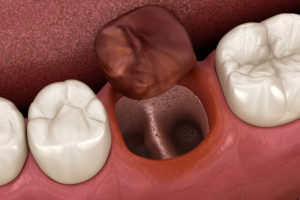
When you have a Tooth Extraction completed, most of the time you will feel some pain. It may be hard to denote if the pain is from the surgery itself, or if you are experiencing a dry socket! Dry sockets are extremely common following any extraction surgery, and they are also extremely painful. No matter what type of extraction you have performed, a dry socket can occur, but they are more typically more common with the removal of lower teeth than they are with removal of upper teeth.
What Are Dry Sockets?
When you have an extraction preformed, a blood clot will form to fill the new hole where your tooth once lived. A dry socket is a condition where the blood clot detaches itself from the socket walls and the extraction site is exposed. Sometimes, the clot will dissolve, leaving the bone exposed to food, drinks and saliva. Once the bone is exposed, it can become inflamed which is when it becomes extremely painful.

Although there is no real way of preventing a dry socket from happening when just extracting a tooth, you can help to reduce the risk by following your doctor’s post-surgery instructions. Even when following post-surgery instructions, dry sockets still have the opportunity to form. Those who are more at risk to dry sockets include those who smoke following extractions, and those who like to grind their teeth frequently.
If you leave the dry socket alone, it will eventually heal and will normally take around a month or so, although the pain won’t let up during the healing period. The best way to fight a dry socket is to go back to your dentist and have them pack the exposed area. It doesn’t take long to complete, and it can provide relief from the pain. When your dentist packs the site, it will allow the nerves to no longer be exposed and the site to heal, while the pain dissipates. This allows, you can get relief from the pain and help the socket heal.
If you are dealing with pain, or are going to have an extraction take place, speak with your dentist on all care instructions. They will help you go through everything you will need to do to take the best care of your mouth, post-surgery. If you do happen to have a dry socket form after your surgery, do not worry – follow your dentist’s instructions and you will heal in no time.
What Are My Options To Avoid Dry Sockets?
Here at Smile Solutions, our favorite solution to dry sockets is to replace the tooth with Dental Implants! Implants have been an increasingly popular solution for missing teeth in recent years due to being able to being able to Osseointergrate into your jawbone. Because the dental implant eventually becomes an integrated part of your jawbone due to the Osseointergration process, it can handle pressure and allow you to consume any kind of food you would like without dietary restrictions!
Due to replacing your tooth’s root, instead of just covering the hole, as would happen with a dental bridge, Dental Implants are the perfect solution to prevent dry sockets when it comes to tooth replacement options!
However, it is vital that a qualified dental professional is the one to place your implant! Although some businesses may try to lure patients in with low costs and cheaper materials, your best chance at a successful procedure is with a doctor properly trained in dental implant placement, using all the newest, modern technology available!
Have More Questions?
These are the very basics, but there is a lot of other information available for tooth extractions and dry sockets. When you are ready to learn more, contact our doctor, Dr. Wehrman, in our office in Fargo, ND to schedule an appointment today!

